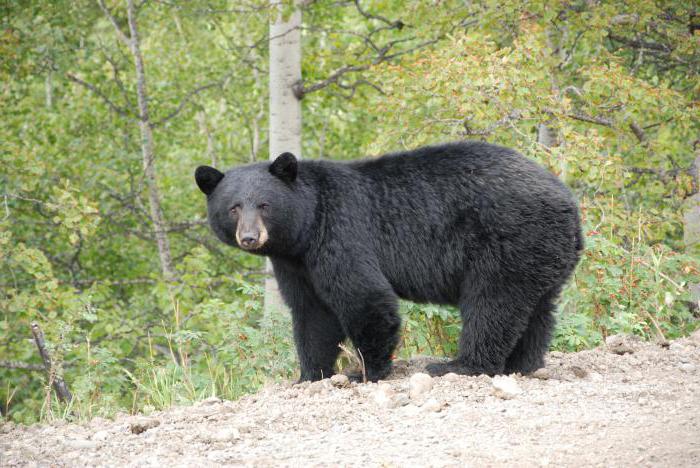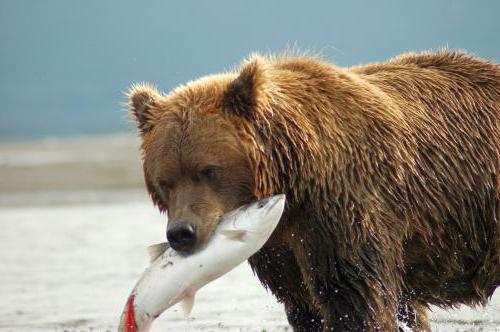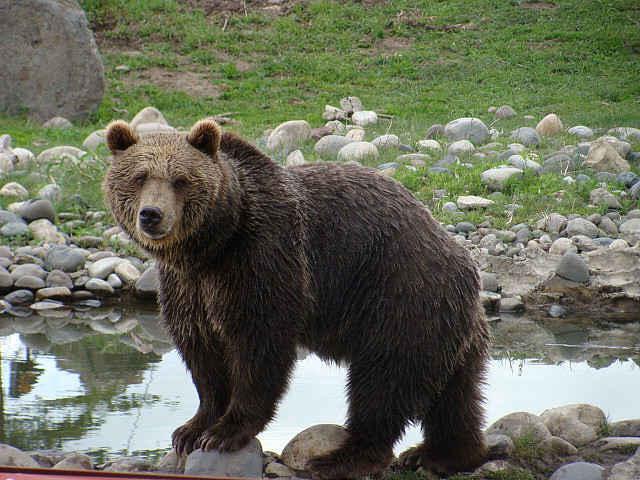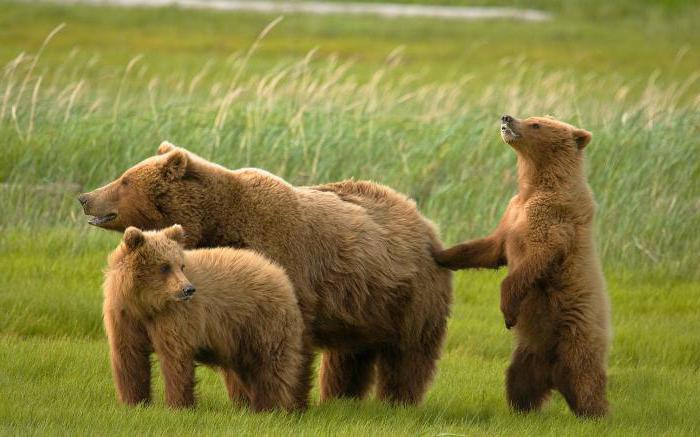A bear is one of the animals that you hardly want to meet face to face. Its dimensions inspire genuine fear. Surprisingly, at birth, some bears weigh less than 200 grams, and the question of how much an adult bear weighs unwittingly arises here. It all depends on its type and individual characteristics. Bears are considered the most famous: brown, black, white. Since a brown bear lives in our country, let us dwell on it in more detail.
Distribution area
Previously, a brown bear was found almost throughout Europe, including in Ireland and England. The southern border of the range was the African Atlas mountains, and in the east, bears were found even in the territory of modern Japan. It most likely entered the territory of North America through the Bering Strait about 40 thousand years ago. Then he settled in the territories from Alaska to the northern borders of Mexico. To date, the brown bear has spread widely in Finland (in this country it was even declared a national animal) and Scandinavia, less common in central Europe and the Carpathians. In addition, it also lives in the Iranian and Iraqi forests, northern China, Palestine, the Korean Peninsula and the Japanese island of Hokkaido. In North America, a brown bear is called a “grizzly bear,” more commonly found in western Canada, Alaska. In Russia, the brown bear lives in almost all forests of the country, except for the southern regions.
Appearance
The animal is strong, with a distinct withers on its back. The body cover is thick. The color of the coat is uniform. As a rule, in the spring the bears molt, and in the fall the fur coat is renewed. The head is large, the ears are small, the eyes are set deep. The tail is almost invisible under the hair and is only 2 cm long. The paws are quite strong, with claws bent (their length can reach 10 cm).
Brown bear weight and size
The average body length of a brown bear is 1-2 meters. The largest bears are recorded in Kamchatka, the Far East and Alaska. These are real giants: their growth in a standing position reaches three meters. In addition to growth, many are interested in how much the bear weighs. Body weight depends on the sex and age of the animal. As a rule, the male is larger than the female. The weight of an adult bear (male) is 140-400 kg. But among them there are giant individuals weighing up to 600 kg. The female weighs 90-210 kg on average. A bear with a record body weight was discovered on the island of Kodiak. His weight was 1134 kg and his height was about 4 meters. Many people wonder how much a brown bear, living in Russia, weighs. In our country, smaller individuals are found, their body weight averages 100 kg. And how much does a grizzly bear weigh - a bear living in America? A grizzly bear is a subspecies of a brown bear; its body weight can reach 500 kg. Individuals can weigh 700 kg.

Life span
How much a bear weighs and how long it lives - these are probably the most frequently asked questions. Note that the life span of an animal depends on its environment. In the wild, he can live 20-35 years. If the animal is kept in a zoo or reserve, then it lives twice as long - about 50 years, or even more. Puberty occurs at 6-11 years of age.
Behavior
The brown bear has a developed sense of smell. He smells good meat even at a great distance. The bear has a well-developed hearing. Often gets up on its hind legs to catch the direction of odor flows or to listen to the sound that interests him. In the forest, he behaves like a real master: he bypasses his possessions in the early morning or after dusk. In bad weather, it can spend hours wandering in the woods in search of food.
Lifestyle and Nutrition Features
A brown bear is considered a forest animal. In Russia, its favorite places are dense forests with shrubs and deciduous trees. It can enter the territory of the tundra and alpine forests. In Europe, it most often lives in the mountains, and in North America, its favorite habitats are alpine meadows, tundra and the coast. The male usually lives alone, and the female with cubs. Each individual occupies a certain territory from 70 to 400 km, while the male requires 7 times larger area than the female. Of course, this does not depend on how much the bear weighs. It's just that a female lives more often with cubs, and it is more difficult for her to walk long distances than a single male. Bears mark the boundaries of their plot with urine and scratches on the trees.

Animals are omnivores. The diet consists of 75% plant foods - these are berries, tubers, herbal stems, nuts, roots and acorns. In lean years, they can feed on corn and oat fields. The diet of the clubfoot can consist of ants, worms, small rodents (mice, chipmunks, gophers). Although the bear is not a wholly predator, it can overwhelm a moose or roe deer. There are frequent cases when grizzlies attacked wolves, and in the Far East, bears sometimes prey on Himalayan bears and tigers. Honey is considered a favorite treat of this animal (that's why it was called that). Fish is a seasonal hunting object. At the beginning of spawning, when there is still little fish, the bear eats the whole carcass, but when there is a lot of it, it eats only parts rich in fat (head, milk and caviar). In hungry years, the bear can hunt for domestic animals and often visits apiaries, ruining them.

Brown bear activity occurs in the morning and evening hours. The way of life is inherent in seasonality. By colds, the bear builds up a subcutaneous layer of fat and lies hibernated in the den. At the same time, the average weight of the bear increases by 20%. The den is a dry place under windbreaks or uprooted rhizomes of trees. On average, winter sleep lasts about 70-190 days and depends on the climate (October-March, November-April). It turns out that clubfoot is in hibernation for about six months. The dipper bears hibernated the longest, the older males less. It is also interesting to know how much a brown bear weighs after winter sleep. During this time, they can lose about 80 kg of weight. If during the summer and autumn the bear did not manage to accumulate a sufficient amount of fat - in the winter he wakes up and begins to wander through the forest in search of food. Such bears are commonly called connecting rods. Cranks are dangerous and hungry, so they attack everyone, even a person. Most often, they rarely live to see the end of winter: they die from frost, severe hunger, or from a bullet from hunters.

Despite the fact that the weight of the brown bear is impressive, and it looks somewhat awkward, it runs pretty fast, swims well and climbs trees perfectly. A paw strike is so powerful that it can break the back of a large bison or a bull.
Breeding
The female brings offspring once every 2-4 years. The estuary passes at the end of spring - the beginning of summer, the duration is only 2-4 weeks. Males during the breeding season often struggle among themselves, sometimes with a fatal outcome. A case of a bear occurs with several males, the course of pregnancy is latent, while the development of the embryo will begin only in November. Pregnancy lasts from 6 to 8 months, the birth itself occurs at the place of hibernation - in the den. In one litter there are up to 5 cubs. I wonder how much a bear weighs at birth, if in the future it reaches such a size? Cubs weigh 340-680 grams at birth, their length is 25 cm. They are born completely blind and deaf, hairline is almost absent. Hearing appears only 14 days after birth, and they become sighted a month later. By the age of 3 months, they have milk teeth, and they can eat berries. The bear feeds the cubs with milk for up to 30 months. As a rule, the father does not take part in raising offspring, on the contrary, he can eat a teddy bear, because he sees in him a potential rival. Cubs begin to live independently without a mother by about 3-4 years.

Security
The brown bear is listed in the Red Book. This beast is vulnerable due to the high mortality of young animals and slow breeding. But lately, the population has been growing. According to some reports, there are about 200 thousand individuals in the world, 120,000 of which live in Russia, 14,000 in Europe, 32,500 in the United States (most in Alaska), 21,500 in Canada. Bear hunting in many countries is limited or completely prohibited.